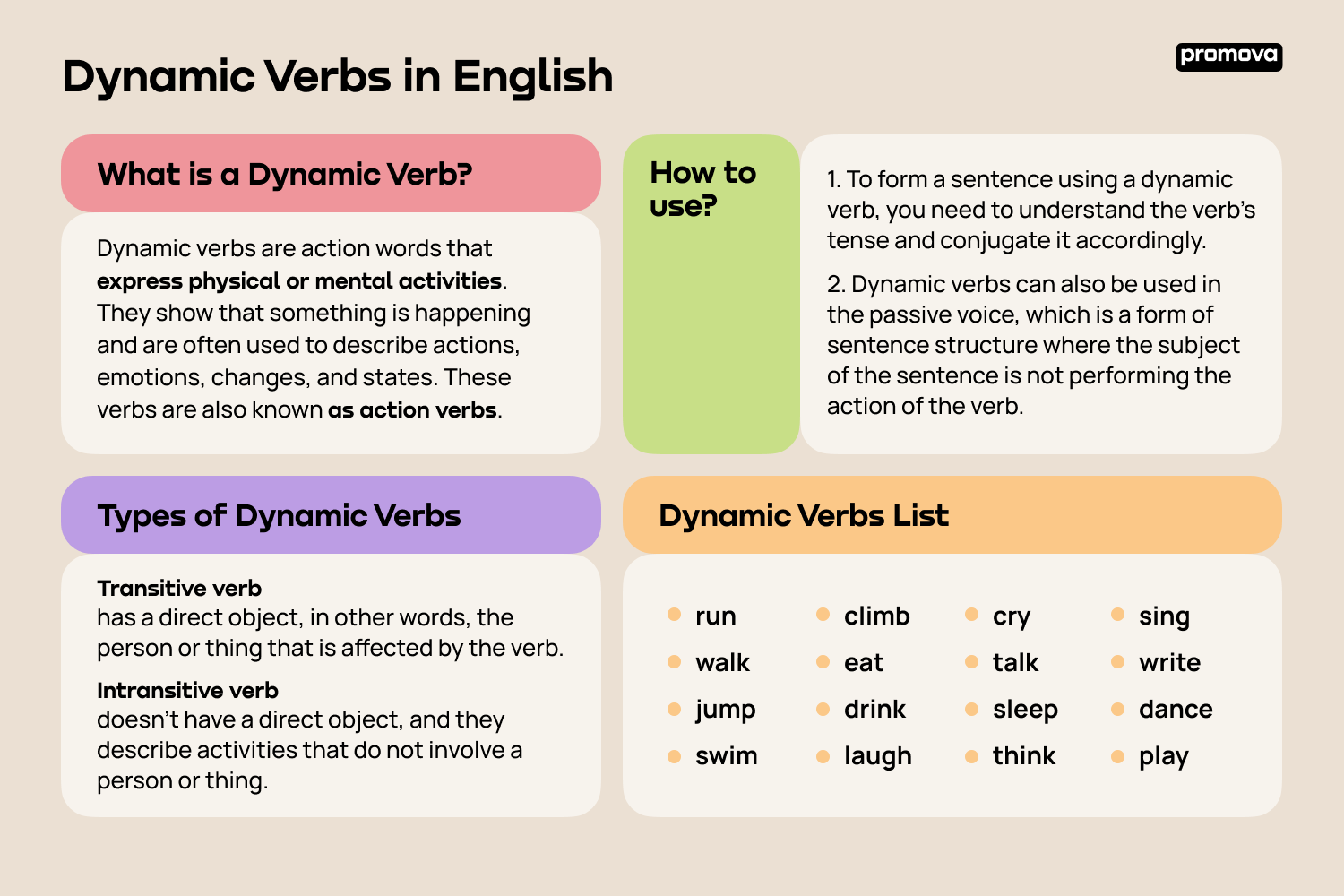Dynamic Verbs in English
Contents
Dynamic verbs are an important part of English grammar and can help you communicate fluently. In this reference, we’ll explore what dynamic verbs are and how to use them in your language. Let's start learning!
What is a Dynamic Verb?
Dynamic verbs are action words that express physical or mental activities. They show that something is happening and are often used to describe actions, emotions, changes, and states. These verbs are also known as action verbs.
Dynamic verbs are contrasted with stative verbs, which describe conditions, states, and feelings. For example, the sentence “I am excited” uses the stative verb “am.”
Dynamic verbs can be used in various tenses, including simple present, present continuous, past, and past continuous. They are often used to express actions in the present and past.
Types of Dynamic Verbs
Dynamic verbs can be divided into two main categories: transitive verbs and intransitive verbs.
A Transitive verb has a direct object, in other words, the person or thing that is affected by the verb.
An Intransitive verb doesn't have a direct object, and they describe activities that do not involve a person or thing.
For example, in the sentence “I read a book,” “read” is a transitive verb because it has a direct object (“book”). In the sentence “I laughed,” “laughed” is an intransitive verb because it does not have a direct object.
Dynamic Verbs List
Here is a list of some common dynamic verbs in English:
- run
- walk
- jump
- swim
- climb
- eat
- drink
- laugh
- cry
- talk
- sleep
- think
- sing
- write
- dance
- play

How to Use Dynamic Verbs
Dynamic verbs can be used in different contexts to express different types of actions. To form a sentence using a dynamic verb, you need to understand the verb’s tense and conjugate it accordingly.
For example, the verb “run” can be conjugated in the present tense as “I run,” in the past tense as “I ran,” and in the future tense as “I will run.”
Dynamic verbs can also be used in the passive voice, which is a form of sentence structure where the subject of the sentence is not performing the action of the verb. For example, the sentence “I was laughed at” is in the passive voice - the subject (“I”) is not doing the action (“laughing”).
Common Mistakes with Dynamic Verbs
One common mistake when using dynamic verbs is using the wrong tense. For example, if the sentence should be in the past tense, using the present tense can change the meaning of the sentence.
Another mistake is using the wrong verb form. For example, using the form “runned” instead of “ran” is incorrect.
Pay attention to the verb’s conjugation. For example, the verb “drink” should be conjugated as “drink” in the present tense and “drank” in the past tense.
Examples of Dynamic Verbs in Sentences
Here are some examples of dynamic verbs in sentences:
- She ran to the store.
- I jumped up and down.
- They swam in the pool.
- He climbed the tree.
- She ate a sandwich.
- We drink a lot of water.
- They laughed at the joke.
- He cried when he heard the news.
- She talked to her friends.
- They slept in late.
- I thought about the situation.
- She sang a song.
- He wrote a letter.
- They danced at the party.
- We played a game.
4
Dynamic Verbs in Different Contexts
Dynamic verbs can be used in different contexts to express different types of actions.
- Express physical activities, such as running, jumping, swimming, and climbing.
- Portray mental activities, such as thinking, dreaming, and so on.
- Express emotions, such as happiness, sadness, anger, and surprise. For example, the verb “laugh” helps express happiness, and the verb “cry” can express sadness.
- Show changes in states, such as becoming awake, becoming tired, and becoming aware. For example, the verb “wake” can be used to express becoming awake, and the verb “realize” can be used to express becoming aware.
Summary
Now that you know more about dynamic verbs, you’ll be able to use them more confidently in your writing and speaking. Remember to use the correct tense and verb form, and pay attention to the context of the sentence. With a little practice, you’ll be able to use dynamic verbs like a pro!
Comments